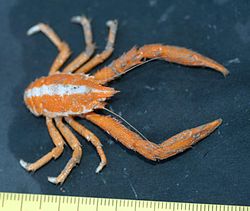| Munidopsidae | |
|---|---|
 | |
| Munidopsis serricornis | |
| Scientific classification | |
| Domain: | Eukaryota |
| Kingdom: | Animalia |
| Phylum: | Arthropoda |
| Class: | Malacostraca |
| Order: | Decapoda |
| Suborder: | Pleocyemata |
| Infraorder: | Anomura |
| Superfamily: | Galatheoidea |
| Family: | Munidopsidae Ortmann, 1898 |
Munidopsidae is a family of crustaceans belonging to the order Decapoda. [1] The Munidopsids are the deepest-dwelling family of superfamily Galatheoidea, which comprises families Galatheidae, Munididae, Munidopsidae, and Porcellanidae. [2]
Munidopsids are one of the most common types of decapod found in abyssal zones, [3] and have been found occupying active hydrothermal vents [4] and cold seeps. [5] Munidopsids reside from slope to abyssal floor, save for the species M. polymorpha, which can be found in submarine caves as shallow as 2 meters below sea level. [6] They are commonly referred to as squat lobsters. [7]
As of 2008, 224 species of Munidopsids have been catalogued: 71 in the Atlantic, 132 in the Pacific, and 50 in the Indian Ocean. [6]